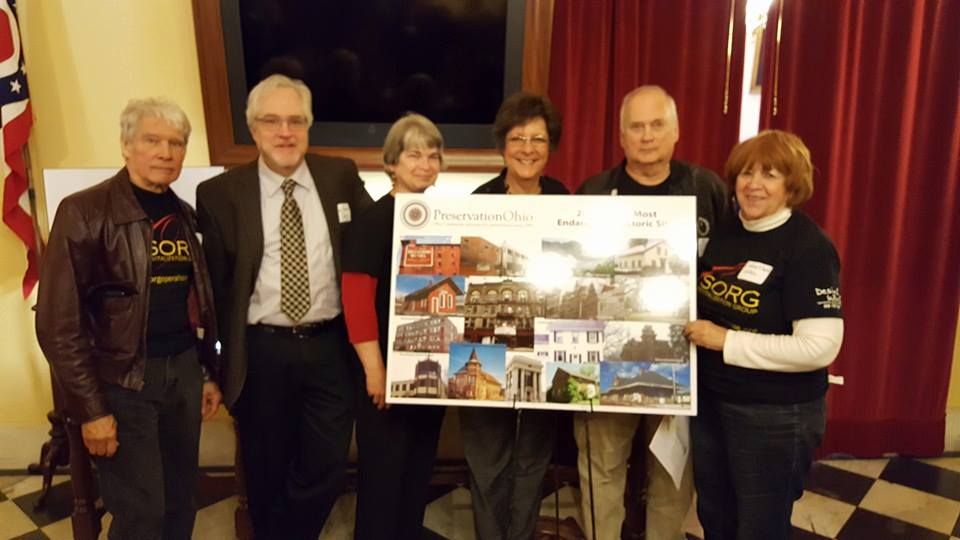The 2015 List of Ohio’s Most Endangered Historic Sites
East Liberty Schoolhouse
Turkeyfoot Lake Road, Akron
Built in 1890, and identified as a significant late 19th Century school building in 1996 on the Ohio Historic Inventory, the school has recently been vacant. It has a number of original features. A plan to build a 10-bay gas station on the site is expected to result in a sale in June 2015. The potential developer and current property owner are willing to give the structure to anyone able to move it off the current site. The Green Historical Society is leading efforts at preservation.
Stone Train Depot/Ashtabula Train Station
32nd Street, Ashtabula
The train station, constructed in the 1800s, is vacant and in danger of being demolished in 2015. A local group has been formed to advocate for moving the structure or turning it into a working Amtrak station with a museum and coffee house. The station is within 1000 feet of the deadliest train bridge collapse in U.S. history: an 1876 tragedy resulting in the death of 83 people.
The Peter Pontius House
Market Avenue, Canton
The 1835 Federal style house was built by Peter Pontius, a farmer mentioned frequently in history accounts as a township supervisor, trustee and school director. He is credited with a proposal to preserve photos of every school in Ohio with updates every 100 years. Such photos were first completed in 1880 and again in 1980. The house, vacant for the past year, is threatened by a plan to widen Market Avenue, leaving almost no lawn barrier between the house and street. The Plain Township Historical Society is leading advocacy efforts to raise awareness of the architectural style of this and other local sites.
Cedar Bank Earthworks
North of Chillicothe, Ross County
Cedar Bank Earthworks is a group of Adena culture earthworks. The site, which was surveyed by Squire and Davis in the 1840s, has never been thoroughly studied. It has an intact 2,000-year-old embankment wall, which is very rare among Ohio’s major earthworks. It can still be seen on the surface and in aerial photography. It is one of the few large earthworks not already preserved within a park.
Elam Drake Farm
Ole Country Lane, Columbus
The Elam Drake Farm includes a house, smoke house and thrashing barn built in the early-mid 1800s. It is currently idle and deteriorating. It is situated adjacent to Port Columbus airport. Unconfirmed plans to lease the property for a car rental facility would likely result in demolition. The farm is named for Elam Drake, a mason and brick maker who moved to Columbus in 1831. He built some of Columbus’ earliest brick buildings and many others through the 1850s. Adaptive reuse or moving the buildings are the best opportunities for preservation.
Original Columbus Airport Terminal
East Fifth Avenue, Columbus
The original Columbus airport terminal is on the National Register of Historic Places. It dates to 1929 and features a classic octagonal observation tower and art deco appointments. The terminal was the site of the first transcontinental flight to Los Angeles. Many dignitaries flew from the terminal including Charles Lindbergh, Amelia Earhart and Henry Ford. The terminal has fallen into disrepair from neglect. The current owner planned demolition, although a local group is advocating for adaptive reuse.
Bellows Avenue School
Bellows Avenue, Columbus
The Bellows Avenue Elementary School, built in 1905, has been idle since 1977. Due to its deterioration, it is scheduled for demolition in 2023, likely to be replaced by a ramp onto I-70. The school was named for George Bellows, Sr., the architect and father of George Bellows, an artist known for his urban realism as an Ash Can School artist. The school is located in a transitioning area and has the curb appeal necessary for successful adaptive reuse.
Historic Homes on Ohio Wesleyan Campus
Oak Hill, West William and Rowlands Streets, Delaware
Ohio Wesleyan University has announced plans to demolish four 19th Century brick homes it owns near campus to make way for new institutional-style student housing. The homes are currently occupied, each housing students interested in particular cultures or courses of study. The elegant Victorian homes appear in good condition and contribute to the historic ambiance of their hilltop neighborhood and the historic Ohio Wesleyan campus.
Allen County Memorial Hall
West Elm Street, Lima
This 1908 historic performing arts center and former city hall was mothballed by local government in November 2014. It is the victim of nearly 30 years of neglect and has been deemed unsafe for public assembly. The Council for the Arts of Greater Lima has created a plan to restore Memorial Hall and discover new and sustainable uses for the facility. With two recent memorial hall demolitions, this building serves as one of the very few survivors across Ohio.
Houghton Sulky Manufacturing Building
State and Huber Streets, Marion
The site served as Marion’s first church from 1845 – 1854, and as the site of Huber Manufacturing from 1866 until the early 1920s when Houghton Sulky purchased the site for the manufacture of horse sulkies and agricultural equipment. Production continued until the site closed in 2006. The property was on the 2014 list of Ohio’s Most Endangered Historic Sites. While preservation efforts have been employed, there is still a threat due to the recent collapse of an 1870s third floor addition.
Old District 10 Schoolhouse
Sheldon Road, Middleburg Heights
Listed on the National Register of Historic Places, this 1912 schoolhouse is the last significant century-old building remaining in Middleburg Heights. It is in a deteriorated state and privately owned. The Middleburg Heights Historical Society is working to preserve the site as a cultural center for the city to recreate the early educational experiences of students in the early 1900s, and as a museum for display and/or storage of artifacts.
Olive Branch High School
National Road, New Carlisle
Built in 1908, and reconstructed in 1913 after a devastating fire, the unique Craftsman style school is a good representative of a rural turn-of-the-century high school. The property was on the 2014 list of Ohio’s Most Endangered Historic Sites. Listed on the National Register of Historic Places, the building is currently used as a warehouse and is suffering from deterioration and water damage. The Olive Branch School Preservation Society was founded in 2007 and continues to advocate and raise funds for preservation of the school.
Wauseon Toledo – Indiana Interurban Railway Depot
Beech Street, Wauseon
The neglected 1905 building was auctioned off in 2014 and purchased by a local citizen who donated it to the Wauseon Downtown Association, saving it from the fate of many of these depots throughout the state. The Association is currently raising funds to stabilize and ultimately restore the building to an office similar to what it would have been in 1905, housing a collection of Toledo & Indiana Railway Company history and lore.



